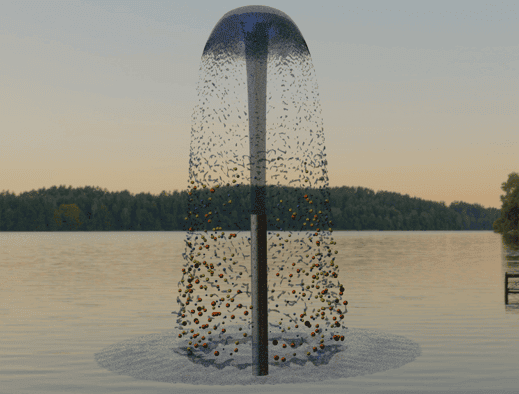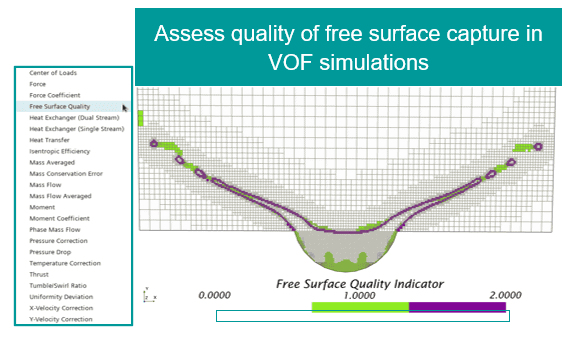It is time again for a multiphase capability update in relation to a new version of Simcenter STAR-CCM+ being released. As usual, we have a number of new updates for the different multiphase applications. As of last version (2402) we are counting SPH to Simcenter STAR-CCM+ multiphase capabilities.
MMP-LSI Phase Interactions with LMP
The first new capability to include is MMP-LSI Phase interaction with LMP. Where before you would typically use the combination of VOF, Fluid film and Lagrangian you can now utilize the MMP-LSI instead of VOF in this combination. Meaning that MMP-LSI is used with Fluid film and Lagrangian to efficiently resolve all regimes of your simulation. You can then resolve free surfaces, films, and ballistic droplets. And you can utilize the MMP model with a population balance for the smallest dispersed liquid droplets.
S-Gamma for MMP-LSI
The second addition to the MMP-LSI is the S-Gamma population balance model, which allows for LMP to pass on to the MMP-phase. The droplet (or bubble) sizes are represented as a log normal distribution which is adjusted based on the transferred droplets coming from LMP. The S-Gamma model also has models to account for the further breakup and coalescence at sub-grid scales which is key to predicting correct droplet and bubble sizes and the transport of dispersed phases.
The animation shows an E-motor where jets from the hub are resolved with LSI, you then have a breakup into Lagrangian droplets as well as into S-Gamma population balance and you also get resolved film on the walls.
LMP droplets to dispersed MMP mixture transition
As the MMP-LSI model is hybridized, some of the capabilities that was previously possible for VOF, also need to be functioning for the MMP-LSI. First off LMP-droplets need to be able to transition into an MMP-mixture. This allows users to limit the Lagrangian droplet population to just the larger ballistic droplets that are having higher momentum and can travel in a different direction to the gas flow. Smaller droplets are transitioned to an MMP mixture. This hybrid approach reduces the computational expense of multiphase simulations. The new phase interaction model allows users to setup a sub-grid transition based on Stokes number, droplet size and other user criteria to transition LMP droplets (or bubbles/particles) to MMP dispersed phase. If the S-Gamma population balance model is active, the size distribution will be adjusted based on the transferred droplets.

LMP Impingement into MMP-LSI Free surfaces
The third leg of this three-pronged milking stool, to get the full hybridization of MMP-LSI into action, includes the transition from LMP to the free surface part of the MMP-LSI. While this has been available for a long time for VOF, we can now directly transition to the free surface. The new impingement phase interaction is applied where LMP droplets (or bubbles) pass into a region of high-volume fraction of the corresponding continuous phase – the LMP mass is then transferred to that phase. This modeling ensures that the most appropriate model is used locally and avoids tracking LMP droplets (or bubbles) in a continuous MMP phase of the same substance. Typically, LMP impingement happens at a sub-grid scale, but cell clustering and AMR can be used if impingement effects are to be resolved.

Fluid film: Habchi Boiling model
Before the only option for boiling of fluid film was Rohsenow boiling. A new model has been added, the Habchi boiling model, which includes Leidenfrost effect and longer film residence times beyond transition compared to Rohsenow. The inclusion of the Leidenfrost effect results in much lower heat transfer rate beyond transition and longer residence times for the film as a result.

VOF: Free surface quality indicator field function and report
Previously the only way to assess the quality of a VOF-interface has been to do a visual inspection. The sharpness of a VOF interface heavily determines how accurate a simulation is. We now have Free surface quality indicator field function together with a report for much easier assessment of the free surface.
The Free Surface Quality Indicator field function has 3 possible values:
- 0 – No Interface: This value is returned when the cell has a volume fraction which represents a continuous phase away from a free surface. By default, this corresponds to volume fractions below 0.01 or above 0.99 (this range can be changed under Physics>Models>Volume of Fluid (VOF)>Interface Detection>Interface Volume Fraction Range)
- 1 – Smeared Interface: This value relates to volume fractions within the range above but that do not correspond to a sharp interface (see below)
- 2 – Sharp Interface: Based on the volume fraction gradient. A cell is marked as containing a sharp interface if the volume fraction gradient is above a certain threshold (max. possible vf. gradient/no. of cells across an interface which is considered sharp). Assessment is based on Physics>Models>Volume of Fluid (VOF)>Interface Detection>Sharp Interface Thickness Criterion which is by default 5.

Transfer model from free-stream to wall-bound phase
The recently added Lagrangian wall bound phase has now also received a transition model from the free-stream LMP phase. This now includes the first ever Lagrangian-Lagrangian phase interaction, in Simcenter STAR-CCM+. It also includes a new deposition model and transfer to the wall-bound phase is located in the boundary condition menu. There will be automatic creation of a parcel transfer injector when the deposition model is activated. You can now elevate your water-management simulation!
Particle agglomeration model
A new contact model, the Particle Agglomeration model, replaces the previously available Parallel bonds model and provides a powerful tool for simulating the particle agglomeration processes in various industrial applications. The benefits of improved realism and reduced computational cost are the consequences of the following new options.
- Two bond formation options, Time Window, and User Defined, significantly extend the type of particle flow applications that can be simulated. Bonds form only when specific local conditions are satisfied. For example, the difference between local temperature and melting temperature, the duration of the contact between particles, the amount of compression at the contact, the amount of the bonding liquid component of the two solid particles in contact, or a combination of several similar factors can trigger the bond formation.
- The Bond Stiffness option allows setting the bond properties to be either derived from the particle’s material or be completely independent from the mechanical properties of particles. In the latter case, this option allows capturing the important aspects of the physics of bond formation in many applications where solid particles are coated with a bonding liquid. For example, it is relevant for simulating wet granulation. The improved realism and accuracy often bring up the reduced computation cost. This is because in many applications the stiffness of bonds is expected to be lower than the particle’s material-based stiffness which increases the DEM time step.
- The formation of bonds between particles and boundaries is allowed. We eliminated a rather big disadvantage of the Parallel bonds model. This is important for simulating the accumulation of particles on boundaries in applications such as airplane wing icing/de-icing, sand ingestion in turbomachinery, and many other particle deposition applications.
The example below shows a simulation of a wet granulator.
Inlet boundary condition for SPH
This first enhancement for the SPH model includes a velocity and mass flow inlet boundary condition. As SPH motion is limited to simple motion, that is the same for the inlet. You can thus now model rotating injectors.
I hope this has been a useful and informative post. Remember that this does not include all of the news for multiphase simulations. A little over half is covered here. The rest can be found in the documentation for Simcenter STAR-CCM+ 2406. Reach out with any questions to support@volupe.com.
Author

Robin Victor
+46731473121
support@volupe.com